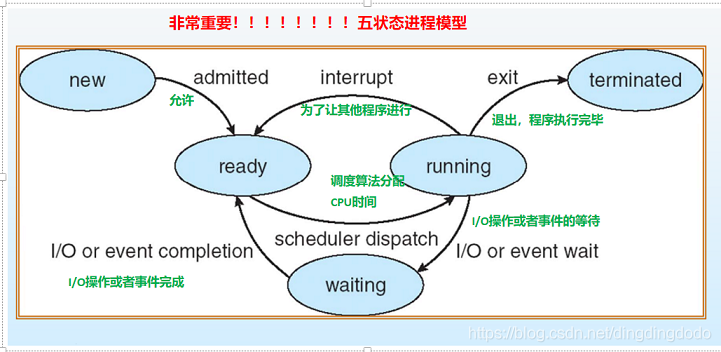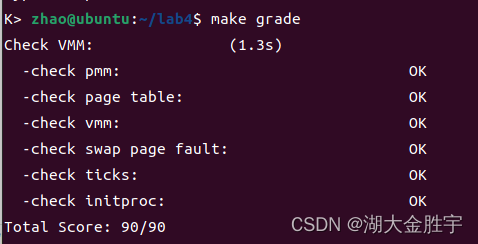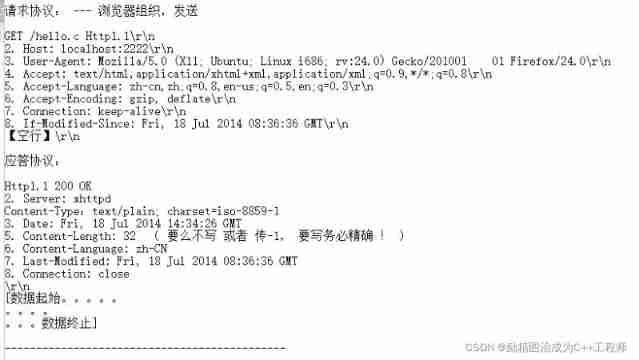当前位置:网站首页>ucorelab4
ucorelab4
2022-07-06 15:24:00 【Hu Da jinshengyu】
lab4
The experiment purpose
- Learn about kernel thread creation / Management process implemented
- Understand the switching and basic scheduling process of kernel threads
Experimental content
experiment 2/3 Completed physical and virtual memory management , This creates a kernel thread ( Kernel thread is a special process ) Laid the foundation for providing memory management . When a program is loaded into memory to run , First, through ucore OS The memory management subsystem allocates appropriate space , Then you need to think about how to use time-sharing CPU Come on “ Concurrent ” Execute multiple programs , Let each program run ( Here, thread or process is used to represent )“ feel ” They each have “ own ” Of CPU.
This experiment will first touch the management of kernel threads . Kernel thread is a special process , There are two differences between kernel threads and user processes :
- Kernel thread only runs in kernel state
- User processes run alternately in user mode and kernel mode
- All kernel threads share ucore Kernel memory space , There is no need to maintain separate memory space for each kernel thread
- User processes need to maintain their own user memory space
See the appendix for the introduction of relevant principles B:【 principle 】 process / Thread properties and characteristics analysis .
practice 0: Fill in the existing experiment
This experiment relies on experiments 1/2/3. Please take your experiment 1/2/3 Fill in the code in this experiment. There are “LAB1”,“LAB2”,“LAB3” The corresponding part of the notes .
Use meld Will experiment 1/2/3 Fill the corresponding part of the code in Experiment 4 :

among , The part to be modified is :
default_pmm.c
pmm.c
swap_fifo.c
vmm.c
trap.c
practice 1: Allocate and initialize a process control block ( Need to code )
alloc_proc function ( be located kern/process/proc.c in ) Assign and return a new struct proc_struct structure , Used to store the management information of the newly established kernel thread .ucore This structure needs to be initialized at the most basic level , You need to complete this initialization process .
【 Tips 】 stay alloc_proc Function implementation , Need to initialize proc_struct The member variables in the structure include at least :state/pid/runs/kstack/need_resched/parent/mm/context/tf/cr3/flags/name.
Please briefly describe your design and implementation process in the experimental report . Please answer the following questions :
- Please explain proc_struct in struct context context and struct trapframe *tf What is the meaning of member variables and their role in this experiment ?( Tip: you can tell by looking at the code and programming debugging )
Prepare knowledge
Some knowledge about the process
The process includes all the status information of a running program , Including code 、 data 、 Register, etc .
Some characteristics of the process :
dynamic : You can create... Dynamically 、 The end of the process
And issued : The process can be called independently and occupy the processor to run
independence : The work between different processes is not affected
conditionality : Multiple processes access shared data 、 Constraints arising from synchronization between resources or processes
Process control block (PCB) It is a collection of information used to manage and control the operation of processes .PCB Is the only sign that a process exists , Each process has a corresponding PCB, For the operating system PCB To describe the basic information of the process and the running changes .PCB Usually contains the process identifier 、 Processor information 、 Process scheduling information 、 Process control information .
Process switching ( Context switch ): Pause the current process , Change from running state to other state , Call another process to change from ready state to running state . In the process , You need to save the process context before switching , So that the process can be resumed later , And switch as quickly as possible ( Therefore, the code of process switching process is usually written in assembly ).CPU Give each task a certain service time , When the time goes round , You need to save the current state , Load the next task at the same time , At this time, context switching is performed .
Classic process five state model (new,ready,waitting,running,terminated):

process was suspended : The process image in the suspended state is on disk , The purpose is to reduce the memory occupied by the process . In contrast, it becomes process activation , Activate the process in the suspended state , Transfer the process from external memory to memory .
Realization
The operating system is process centric , So its first task is to establish archives for the process , The process file is used to represent 、 Identify or describe the process , Process control block . What needs to be done here is the initialization of a process control block .
Here we allocate a kernel thread PCB, It is usually just a small piece of code or function in the kernel , No user space . And because after the operating system starts , The entire core memory space has been managed , The core virtual space is established by setting the page table ( namely boot_cr3 The space described by the secondary page table pointed to ). Therefore, all threads in the kernel no longer need to establish their own page tables , Just share this core virtual space to access the entire physical memory .
First, in the kern/process/proc.h It defines PCB, That is, the structure of the process control block proc_struct, as follows :
struct proc_struct {
// Process control block
enum proc_state state; // Process status
int pid; // process ID
int runs; // The elapsed time
uintptr_t kstack; // Kernel stack location
volatile bool need_resched; // Whether it needs to be scheduled
struct proc_struct *parent; // The parent process
struct mm_struct *mm; // Virtual memory of the process
struct context context; // Process context
struct trapframe *tf; // Pointer to the current interrupt frame
uintptr_t cr3; // Current page table address
uint32_t flags; // process
char name[PROC_NAME_LEN + 1];// Process name
list_entry_t list_link; // Process linked list
list_entry_t hash_link; // Process hash table
};
Combined with the experimental instructions to analyze PCB Meaning of parameters :
- state: The state of the process .
- PROC_UNINIT // No initial state
- PROC_SLEEPING // sleep ( Blocking ) state
- PROC_RUNNABLE // Running and ready
- PROC_ZOMBIE // A dead state
- pid: process id Number .
- kstack: Records the assigned to the process / The location of the kernel of the thread .
- need_resched: Whether it needs to be scheduled
- parent: The parent process of the user process .
- mm: That is, the structure describing the process virtual memory in Experiment 3
- context: The context of the process , For process switching .
- tf: Pointer to the interrupt frame , Always point to a location on the kernel stack . The interrupt frame records the status of the process before it is interrupted .
- cr3: The address of the currently used page table is recorded
see alloc_proc function , This function is responsible for creating and initializing a new proc_struct Structure stores kernel thread information , adopt kmalloc Function can apply for memory space for related data information , Then initialize . There is a trick in the initial process , For member variables that contain more variables or variables that occupy a larger space , have access to memset To initialize . Pay attention to the reasonable initialization of each variable ( Initialize to 0 Or some special values ). Initialize the variables one by one according to the prompt of the code comment , Generally speaking, it is relatively easy .
// alloc_proc - Responsible for creating and initializing a new proc_struct Structure stores kernel thread information
static struct proc_struct *
alloc_proc(void)
{
// Apply for space for the created thread
struct proc_struct *proc = kmalloc(sizeof(struct proc_struct));
if (proc != NULL)
{
//LAB4:EXERCISE1 YOUR CODE
// Because there is no physical page allocated , Therefore, the thread state is initially set to the initial state
proc->state=PROC_UNINIT;
proc->pid=-1; //id Initialize to -1
proc->runs=0; // Run at 0
proc->kstack=0;
proc->need_resched=0; // No need to release CPU, Because it has not been allocated
proc->parent=NULL; // There is currently no parent process , For the initial null
proc->mm=NULL; // Currently unallocated memory , For the initial null
// use memset It's very convenient to context All member variables in the variable are set to 0
// Avoid the trouble of assigning values one by one ..
memset(&(proc -> context), 0, sizeof(struct context));
proc->tf=NULL; // There are currently no interrupt frames , For the initial null
proc->cr3=boot_cr3; // Kernel thread ,cr3 be equal to boot_cr3
proc->flags=0;
memset(proc -> name, 0, PROC_NAME_LEN);
}
return proc;
}
The running process of the entire allocation initialization function is :
- Allocate a memory space on the heap to store process control blocks
- Initialize the parameters in the process control block
- Return the allocated process control block
Question 1 :struct context context and struct trapframe *tf member Meaning and function of variables
According to the prompt, we check the relevant code ( By looking up definitions tf as well as context Function of ):
First we found kernel_thread Functions and copy_thread function , It is known that this function is right tf Set up , Also on context Of esp and eip Set up ( The specific setting process is given in the code comments ):
/* kernel_thread Function uses local variables tf To place a temporary interrupt frame that holds the kernel thread , And pass the pointer of the interrupt frame to do_fork function , and do_fork Function will call copy_thread Function to allocate a space on the newly created process kernel stack for the interrupt frame of the process */
int kernel_thread(int (*fn)(void *), void *arg, uint32_t clone_flags) {
struct trapframe tf;
memset(&tf, 0, sizeof(struct trapframe));
//kernel_cs and kernel_ds The code and data segments representing the kernel thread are in the kernel
tf.tf_cs = KERNEL_CS;
tf.tf_ds = tf.tf_es = tf.tf_ss = KERNEL_DS;
//fn Refers to the actual thread entry address
tf.tf_regs.reg_ebx = (uint32_t)fn;
tf.tf_regs.reg_edx = (uint32_t)arg;
//kernel_thread_entry Used to do some initialization work
tf.tf_eip = (uint32_t)kernel_thread_entry;
return do_fork(clone_flags | CLONE_VM, 0, &tf);
}
static void
copy_thread(struct proc_struct *proc, uintptr_t esp, struct trapframe *tf)
{
// take tf To initialize
proc->tf = (struct trapframe *)(proc->kstack + KSTACKSIZE) - 1;
*(proc->tf) = *tf;
proc->tf->tf_regs.reg_eax = 0;
// Set up tf Of esp, Information indicating interrupt stack
proc->tf->tf_esp = esp;
proc->tf->tf_eflags |= FL_IF;
// Yes context Set it up
//forkret It mainly deals with the returned interrupt , Basically, it can be regarded as an interrupt processing and recovery
proc->context.eip = (uintptr_t)forkret;
proc->context.esp = (uintptr_t)(proc->tf);
}
By combining the above functions switch.S Chinese vs context The operation of , Save the values of various registers to context in . We can know context It is related to context switching , and tf It is related to the processing of interrupts .
Specific answer :
context effect :
The context of the process , For process switching . It mainly saves the site of the previous process ( Status of each register ). stay uCore in , All processes are relatively independent in the kernel . Use context The purpose of saving registers is to switch between contexts in kernel mode . The actual use of context The function for context switching is in kern/process/switch.S In the definition of switch_to.
tf effect :
Pointer to the interrupt frame , Always point to a location on the kernel stack : When a process jumps from user space to kernel space , The interrupt frame records the status of the process before it is interrupted . When the kernel needs to jump back into user space , The interrupt frame needs to be adjusted to recover the values of each register that allows the process to continue execution . besides ,uCore The kernel allows nested interrupts . Therefore, to ensure that nested interrupts occur tf Always able to point to the current trapframe,uCore Maintained on the kernel stack tf Chain .
practice 2: Allocate resources for newly created kernel threads ( Need to code )
Creating a kernel thread requires a lot of resources to be allocated and set up .kernel_thread Function by calling do_fork Function to complete the creation of specific kernel threads .do_kernel Function will call alloc_proc Function to allocate and initialize a process control block , but alloc_proc Just found a small piece of memory to record the necessary information of the process , These resources are not actually allocated .ucore Usually by do_fork Actually create a new kernel thread .do_fork The role of is , Create a copy of the current kernel thread , Their execution context 、 Code 、 The data are the same , But the storage location is different . In the process , New kernel threads need to be allocated resources , And copy the state of the original process . You need to finish in kern/process/proc.c Medium do_fork Processing procedure in function . Its general execution steps include :
- call alloc_proc, First, get a block of user information .
- Assign a kernel stack to the process .
- Copy the memory management information of the original process to the new process ( But kernel threads don't have to do this )
- Copy the original process context to the new process
- Add a new process to the process list
- Wake up a new process
- Return the new process number
Please briefly describe your design and implementation process in the experimental report . Please answer the following questions :
- Please explain ucore Whether to give each new fork A unique thread id? Please explain your analysis and reasons .
Prepare knowledge
According to the notes, we know the purpose and usage of several functions :
// Create a proc And initialize all member variables
void alloc_proc(void)
// Allocate physical pages for a kernel thread
static int setup_kstack(struct proc_struct *proc)
// I haven't seen its use for the time being , Maybe later lab use
static int copy_mm(uint32_t clone_flags, struct proc_struct *proc)
// Copy the original process context to the new process
static void copy_thread(struct proc_struct *proc, uintptr_t esp, struct trapframe *tf)
// Return to one pid
static int get_pid(void)
// take proc Add to hash_list
static void hash_proc(struct proc_struct *proc)
// Wake up the thread , Set the status of this thread to be able to run
void wakeup_proc(struct proc_struct *proc);

Above, eflags register
Macro definition :
#define local_intr_save(x) \ do {
x = __intr_save(); } while (0)
#define FL_IF 0x00000200
#define local_intr_restore(x) __intr_restore(x);
The following is the specific implementation process :
According to the requirements ,do_fork() The implementation steps of the function include seven steps , Then, according to the comments, the general implementation process is as follows :
① call alloc_proc() Function request memory block , If you fail , Directly return to processing .alloc_proc() The function was implemented in exercise 1 , If the allocation process PCB Failure , in other words , The process starts with NULL, Then it will be if(proc!=NULL) Judged as no , Then initialization resources will not be allocated , There are no initialization resources , So it's going to return NULL.
② call setup_kstack() Function to allocate a kernel stack for the process . You can see from the function code below , If the page is not empty , Meeting return 0, That is to say, the allocation of kernel stack is successful ( The basis for this speculation is , the last one return -E_NO_MEM, Presumably, it is an initialized or wrong state , Because in the first part of this function, you don't need to implement , This value is assigned to ret), So it's going to return 0, Otherwise, it returns a strange thing . therefore , We call this function to allocate a kernel stack space , And judge whether the allocation is successful .
static int
setup_kstack(struct proc_struct *proc) {
struct Page *page = alloc_pages(KSTACKPAGE);
if (page != NULL) {
proc->kstack = (uintptr_t)page2kva(page);
return 0;
}
return -E_NO_MEM;
}
③ call copy_mm() function , Copy the memory information of the parent process to the child process . For this function, you can see , process proc Copy or share the current process current, It's based on clone_flags To decide , If it is clone_flags & CLONE_VM( It's true ), Then you can copy . Nothing seems to be done in this function , Just make sure current Whether the virtual memory of the current process is empty , Then the specific operation , Just pass in what it needs clone_flag Can , We don't need to do the rest .
static int
copy_mm(uint32_t clone_flags, struct proc_struct *proc) {
assert(current->mm == NULL);
/* do nothing in this project */
return 0;
}
④ call copy_thread() Function copies the interrupt frame and context information of the parent process .copy_thread() The function requires three parameters passed in , The first is more familiar , What has been achieved in exercise 1 PCB modular proc The object of the structure , The second parameter , It's a stack , The basis of judgment is its data type , In exercise one PCB Module , The data type defined for the stack is uintptr_t, The third parameter is also familiar , It is practice one PCB Pointer to the interrupt frame in .
static void
copy_thread(struct proc_struct *proc, uintptr_t esp, struct trapframe *tf) {
proc->tf = (struct trapframe *)(proc->kstack + KSTACKSIZE) - 1;
*(proc->tf) = *tf;
proc->tf->tf_regs.reg_eax = 0;
proc->tf->tf_esp = esp;
proc->tf->tf_eflags |= FL_IF;
proc->context.eip = (uintptr_t)forkret;
proc->context.esp = (uintptr_t)(proc->tf);
}
⑤ Add a new process to the process's (hash) In the list . call hash_proc This function can add the current new process to the Hash list of the process , analysis hash Features of functions , Call directly hash(proc) that will do .
hash_proc(struct proc_struct *proc) {
list_add(hash_list + pid_hashfn(proc->pid), &(proc->hash_link));
}
⑥ Wake up a new process .
⑦ Return to the new process pid.
do_fork Implementation of function :
int
do_fork(uint32_t clone_flags, uintptr_t stack, struct trapframe *tf) {
int ret = -E_NO_FREE_PROC;
struct proc_struct *proc;
if (nr_process >= MAX_PROCESS) {
goto fork_out;
}
ret = -E_NO_MEM;
//1: call alloc_proc() Function request memory block , If you fail , Directly return to processing
if ((proc = alloc_proc()) == NULL) {
goto fork_out;
}
//2. Set the parent node of the child process as the current process
proc->parent = current;
//3. call setup_stack() Function to allocate a kernel stack for the process
if (setup_kstack(proc) != 0) {
goto bad_fork_cleanup_proc;
}
//4. call copy_mm() Function copies the memory information of the parent process to the child process
if (copy_mm(clone_flags, proc) != 0) {
goto bad_fork_cleanup_kstack;
}
//5. call copy_thread() Function copies the interrupt frame and context information of the parent process
copy_thread(proc, stack, tf);
//6. Add a new process to the process's hash In the list
bool intr_flag;
local_intr_save(intr_flag);
{
proc->pid = get_pid();
hash_proc(proc); // Building mapping
nr_process ++; // Number of processes plus 1
list_add(&proc_list, &(proc->list_link));// Add the process to the linked list of the process
}
local_intr_restore(intr_flag);
// 7. Everything is ready. , Wake up subprocess
wakeup_proc(proc);
// 8. Returns the pid
ret = proc->pid;
fork_out:
return ret;
bad_fork_cleanup_kstack:
put_kstack(proc);
bad_fork_cleanup_proc:
kfree(proc);
goto fork_out;
}
Question 1 :ucore Whether to give each new fork A unique thread id?
uCore in , Every new fork There is only one thread ID, For the following reasons :
- In function get_pid in , If static member last_pid Less than next_safe, The currently allocated last_pid It must be safe , The only one PID.
- But if last_pid Greater than or equal to next_safe, perhaps last_pid The value of exceeds MAX_PID, Then the current last_pid Is not necessarily the only PID, At this point, you need to traverse proc_list, Back to the last_pid and next_safe Set it up , For the next time get_pid Call to lay the foundation .
Next, you may want to analyze the content of this function :
Two static local variables are used in this function next_safe and last_pid, According to the naming conjecture , Every time you enter get_pid Function , The values between the values of these two variables are legal pid( That is to say, it has not been used ), In this case , If there are strict next_safe > last_pid + 1, Then you can directly take last_pid + 1 As new pid( need last_pid Not beyond MAX_PID To become 1);
If you enter the function , There is no legal value after these two variables , in other words next_safe > last_pid + 1 Don't set up , Then enter the cycle , Pass first in the cycle if (proc->pid == last_pid) This branch ensures that there are no processes pid And last_pid coincidence , And then through if (proc->pid > last_pid && next_safe > proc->pid) This judgment statement ensures that there is no existing pid Satisfy :last_pid < pid < next_safe, This ensures that such a conditional interval can be found in the end , Get legal pid;
The reason why such a tortuous method is used in this function , Maintain a legal pid The range of , To optimize time efficiency , If it's simple violence , Every time you need to enumerate all pid, And traverse all threads , This makes the cost of time too high , And different calls get_pid When calling this function, you cannot use the intermediate result of the previous call to this function ;
getpid Function as follows :
// get_pid - alloc a unique pid for process
static int
get_pid(void) {
// actually , It was defined before MAX_PID=2*MAX_PROCESS, signify ID The total number of is greater than PROCESS The total number of
// So there will be no part PROCESS nothing ID Separable situation
static_assert(MAX_PID > MAX_PROCESS);
struct proc_struct *proc;
list_entry_t *list = &proc_list, *le;
//next_safe and last_pid Two variables , Here we need to pay attention to ! They are static Global variables !!!
static int next_safe = MAX_PID, last_pid = MAX_PID;
//++last_pid>-MAX_PID, explain pid And to the end , We need to start all over again
if (++ last_pid >= MAX_PID)
{
last_pid = 1;
goto inside;
}
if (last_pid >= next_safe)
{
inside:
next_safe = MAX_PID;
repeat:
//le Equal to the chain header of the thread
le = list;
// Go through the list
// Cycle through each current process : When an existing process number and last_pid When equal , Will last_pid+1;
// When the existing process number is greater than last_pid when , This means that in the process of scanning
//[last_pid,min(next_safe, proc->pid)] This process number has not been occupied , Continue scanning .
while ((le = list_next(le)) != list)
{
proc = le2proc(le, list_link);
// If proc Of pid And last_pid equal , Will last_pid Add 1
// Of course , If last_pid>=MAX_PID,then Turn it into 1
// Ensure that there is no process pid And last_pid coincidence
if (proc->pid == last_pid)
{
if (++ last_pid >= next_safe)
{
if (last_pid >= MAX_PID)
{
last_pid = 1;
}
next_safe = MAX_PID;
goto repeat;
}
}
//last_pid<pid<next_safe, Make sure you can finally find such a qualified interval , Get legal pid;
else if (proc->pid > last_pid && next_safe > proc->pid)
{
next_safe = proc->pid;
}
}
}
return last_pid;
}
practice 3: Reading the code , understand proc_run Function and the function it calls how to complete process switching .( No coding work )
Please briefly explain your understanding of proc_run Analysis of functions . And answer the following questions :
- During the execution of this experiment , Several kernel threads were created and run ?
- sentence
local_intr_save(intr_flag);....local_intr_restore(intr_flag);What is the role here ? Please give reasons
After the code is written , Compile and run the code :make qemu
If you can get something like appendix A As shown in ( For reference only , Not standard answer output ), Is basically correct .
Prepare knowledge
The experimental instruction is based on ,uCore in , The first process of the kernel idleproc Will execute cpu_idle function , And call... From it schedule function , Ready to start scheduling process , Complete process scheduling and process switching .
void cpu_idle(void) {
while (1)
if (current->need_resched)
schedule();
}
schedule Function code analysis :
/* Macro definition : #define le2proc(le, member) \ to_struct((le), struct proc_struct, member)*/
void
schedule(void) {
bool intr_flag; // Define interrupt variables
list_entry_t *le, *last; // At present list, Next list
struct proc_struct *next = NULL; // Next process
local_intr_save(intr_flag); // Interrupt inhibit function
{
current->need_resched = 0; // Setting the current process does not require scheduling
//last Whether it is idle process ( The first process created ), If it is , Search from the header
// Otherwise, get the next linked list
last = (current == idleproc) ? &proc_list : &(current->list_link);
le = last;
do {
// Cycle all the time , Until you find a process that can be scheduled
if ((le = list_next(le)) != &proc_list) {
next = le2proc(le, list_link);// Get the next process
if (next->state == PROC_RUNNABLE) {
break; // Find a process that can be scheduled ,break
}
}
} while (le != last); // Cycle through the entire linked list
if (next == NULL || next->state != PROC_RUNNABLE) {
next = idleproc; // No process can be scheduled
}
next->runs ++; // Number of runs plus one
if (next != current) {
proc_run(next); // Run new process , call proc_run function
}
}
local_intr_restore(intr_flag); // Allow the interrupt
}
You can see ucore What we achieve is FIFO Scheduling algorithm :
1 When scheduling starts , Mask the interrupt first .
2 In the process linked list , Find the first program that can be scheduled
3 Run new process , Allow the interrupt
chedule Function will clear the scheduling flag first , And start from the position of the current process in the linked list , Traverse the process control block , Until you find the process in the ready state .
After performing proc_run function , Switch the environment to the context of the process and continue execution .
Mention context switching , You need to use switch_to function :
switch_to: # switch_to(from, to)
# save from's registers
movl 4(%esp), %eax # preservation from The first address
popl 0(%eax) # Save the return value to context Of eip
movl %esp, 4(%eax) # preservation esp Value to context Of esp
movl %ebx, 8(%eax) # preservation ebx Value to context Of ebx
movl %ecx, 12(%eax) # preservation ecx Value to context Of ecx
movl %edx, 16(%eax) # preservation edx Value to context Of edx
movl %esi, 20(%eax) # preservation esi Value to context Of esi
movl %edi, 24(%eax) # preservation edi Value to context Of edi
movl %ebp, 28(%eax) # preservation ebp Value to context Of ebp
# restore to's registers
movl 4(%esp), %eax # preservation to First address to eax
movl 28(%eax), %ebp # preservation context Of ebp To ebp register
movl 24(%eax), %edi # preservation context Of ebp To ebp register
movl 20(%eax), %esi # preservation context Of esi To esi register
movl 16(%eax), %edx # preservation context Of edx To edx register
movl 12(%eax), %ecx # preservation context Of ecx To ecx register
movl 8(%eax), %ebx # preservation context Of ebx To ebx register
movl 4(%eax), %esp # preservation context Of esp To esp register
pushl 0(%eax) # take context Of eip Pressure into the stack
ret
therefore switch_to The function mainly completes the context switching of the process , First save the value of the current register , Then save the context information of the next process to the corresponding register .
proc_run function
void
proc_run(struct proc_struct *proc) {
if (proc != current) {
bool intr_flag;// Define interrupt variables
struct proc_struct *prev = current, *next = proc;
local_intr_save(intr_flag); // Mask interrupt
{
current = proc;// Modify the current process as a new process
load_esp0(next->kstack + KSTACKSIZE);// modify esp
lcr3(next->cr3);// Modify page table entry , Complete the page table switching between processes
switch_to(&(prev->context), &(next->context));// Context switch
}
local_intr_restore(intr_flag); // Allow the interrupt
}
}
Realize the idea :
- Give Way current Point to next Kernel thread initproc;
- Set the task status segment ts Medium privileged state 0 Top of stack pointer under esp0 by next Kernel thread initproc The top of the kernel stack , namely next->kstack + KSTACKSIZE ;
- Set up CR3 The value of the register is next Kernel thread initproc The starting address of the page table of contents next->cr3, This actually completes the page table switching between processes ;
- from switch_to Function to switch between two threads , That is, switch each register , When switch_to Function execution finished “ret” After the instruction , Just switch to initproc Yes
Question 1 : During the execution of this experiment , Several kernel threads were created and run ?
Two , Namely idleproc and initproc.
- idleproc: The first kernel process , Complete the initialization of each subsystem in the kernel , Then dispatch immediately , Perform other processes .
- initproc: The kernel process scheduled to complete the function of the experiment .
Question two : sentence A What is the role here ? Please give reasons .
The functions are shielding interrupt and opening interrupt , To prevent other processes from scheduling when the process switches . That is to protect the process switching from being interrupted , To prevent other processes from scheduling when the process switches , It's equivalent to a mutex . This operation is also required when adding processes to the list in step 6 , Because when the process enters the list , A series of scheduling events may occur , For example, we are familiar with steals and so on , Adding such a protection mechanism can ensure that the process execution is not disrupted .
experimental result
Input make qemu Compare with the experimental instruction :

Found the same , It shows that the experiment is successful .
Next , Input make grade The following results can be obtained :

Extended exercises Challenge: The implementation supports memory allocation algorithms of any size
This is not the content of this experiment , In fact, it is the expansion of memory in the last experiment , But considering the present slab The algorithm is complex , It is necessary to implement a relatively simple arbitrary size memory allocation algorithm . Refer to slab How to call the page based memory allocation algorithm ( Be careful , Not for your attention slab The concrete realization of ) To achieve first-fit/best-fit/worst-fit/buddy Support memory allocation algorithm of any size .
Implementation process
With a few modifications , You can use the experiment 2 Extended exercises achieve Slub Algorithm .
- initialization Slub Algorithm : Initialize at the end of initializing physical memory Slub ;
void pmm_init(void) {
...
kmem_int();
}
- stay vmm.c Use in Slub Algorithm :
In order to use Slub Algorithm , You need to declare the pointer of the warehouse .
struct kmem_cache_t *vma_cache = NULL;
struct kmem_cache_t *mm_cache = NULL;
Create a warehouse when the virtual memory is initialized .
void vmm_init(void) {
mm_cache = kmem_cache_create("mm", sizeof(struct mm_struct), NULL, NULL);
vma_cache = kmem_cache_create("vma", sizeof(struct vma_struct), NULL, NULL);
...
}
stay mm_create and vma_create Use in Slub Algorithm .
struct mm_struct *mm_create(void) {
struct mm_struct *mm = kmem_cache_alloc(mm_cache);
...
}
struct vma_struct *vma_create(uintptr_t vm_start, uintptr_t vm_end, uint32_t vm_flags) {
struct vma_struct *vma = kmem_cache_alloc(vma_cache);
...
}
stay mm_destroy Free memory in .
void
mm_destroy(struct mm_struct *mm) {
...
while ((le = list_next(list)) != list) {
...
kmem_cache_free(mm_cache, le2vma(le, list_link)); //kfree vma
}
kmem_cache_free(mm_cache, mm); //kfree mm
...
}
- stay proc.c Use in Slub Algorithm :
Declare warehouse pointer .
struct kmem_cache_t *proc_cache = NULL;
Create a warehouse in the initialization function .
void proc_init(void) {
...
proc_cache = kmem_cache_create("proc", sizeof(struct proc_struct), NULL, NULL);
...
}
stay alloc_proc Use in Slub Algorithm .
static struct proc_struct *alloc_proc(void) {
struct proc_struct *proc = kmem_cache_alloc(proc_cache);
...
}
Refer to the answer analysis :
It is almost the same as the reference answer .
The knowledge points involved in the experiment are listed :
- process
- Process control block
- Process status
- process was suspended
- Threads
- Concept
- Advantages and disadvantages
- User thread and kernel thread
- Comparison between thread and process
Experience and experience :
This experiment is compared with lab1、lab2 as well as lab3 experiment , Generally speaking, the content of the experiment is less , But the knowledge needed is more in-depth . Learned more knowledge .
}
kmem_cache_free(mm_cache, mm); //kfree mm
...
}
- stay proc.c Use in Slub Algorithm :
Declare warehouse pointer .
```c
struct kmem_cache_t *proc_cache = NULL;
Create a warehouse in the initialization function .
void proc_init(void) {
...
proc_cache = kmem_cache_create("proc", sizeof(struct proc_struct), NULL, NULL);
...
}
stay alloc_proc Use in Slub Algorithm .
static struct proc_struct *alloc_proc(void) {
struct proc_struct *proc = kmem_cache_alloc(proc_cache);
...
}
Refer to the answer analysis :
It is almost the same as the reference answer .
The knowledge points involved in the experiment are listed :
- process
- Process control block
- Process status
- process was suspended
- Threads
- Concept
- Advantages and disadvantages
- User thread and kernel thread
- Comparison between thread and process
Experience and experience :
This experiment is compared with lab1、lab2 as well as lab3 experiment , Generally speaking, the content of the experiment is less , But the knowledge needed is more in-depth . Learned more knowledge .
边栏推荐
- Servlet
- Crawling cat's eye movie review, data visualization analysis source code operation instructions
- Take you to use wxpy to create your own chat robot (plus wechat interface basic data visualization)
- UCORE lab2 physical memory management experiment report
- Automated testing problems you must understand, boutique summary
- Brief description of compiler optimization level
- LeetCode#237. Delete nodes in the linked list
- Thinking about three cups of tea
- Sleep quality today 81 points
- Dlib detects blink times based on video stream
猜你喜欢

Mysql database (I)

UCORE lab1 system software startup process experimental report

How to become a good software tester? A secret that most people don't know
![Cadence physical library lef file syntax learning [continuous update]](/img/0b/75a4ac2649508857468d9b37703a27.jpg)
Cadence physical library lef file syntax learning [continuous update]
Interview answering skills for software testing

Brief introduction to libevent

Video scrolling subtitle addition, easy to make with this technique

12306: mom, don't worry about me getting the ticket any more (1)

如何成为一个好的软件测试员?绝大多数人都不知道的秘密

JS --- detailed explanation of JS DOM (IV)
随机推荐
软件测试行业的未来趋势及规划
ucorelab3
Réponses aux devoirs du csapp 7 8 9
JS --- JS function and scope (II)
UCORE LaB6 scheduler experiment report
Stc-b learning board buzzer plays music 2.0
Introduction to variable parameters
How to rename multiple folders and add unified new content to folder names
Cadence physical library lef file syntax learning [continuous update]
自动化测试中敏捷测试怎么做?
LeetCode#412. Fizz Buzz
Introduction to safety testing
软件测试方法有哪些?带你看点不一样的东西
Lab 8 file system
STM32学习记录:输入捕获应用
12306: mom, don't worry about me getting the ticket any more (1)
C4D quick start tutorial - Introduction to software interface
[200 opencv routines] 98 Statistical sorting filter
接口测试面试题及参考答案,轻松拿捏面试官
Eigen User Guide (Introduction)
